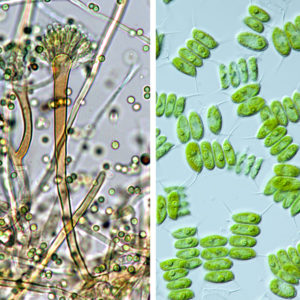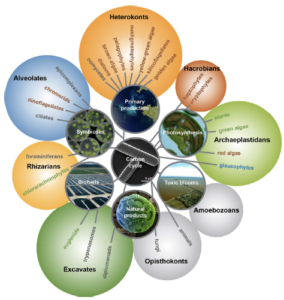
The Fungal & Algal Program scales up sequencing and analysis of fungal and algal genomes to explore functional the characterization of stains that play a critical role in bioenergy and environmental research.
The Fungal & Algal Program, led by Igor Grigoriev, targets the large-scale sequencing and analysis of fungal and algal genomes to explore the diversity of fungi and algae. Encoded in the genomes of these organisms are biological mechanisms with relevance to the DOE missions in biofuels and bioproducts process development, the characterization of carbon cycling, and biogeochemistry. Combining new sequencing technologies and comparative genomics analysis, JGI works on large and complex sequencing projects such as surveying the broad phylogenetic and ecological diversity of fungi and algae, and capturing genomic variation in natural populations and engineered strains and promoting functional studies on a system level. This approach enables JGI to build a foundation for translating the genomic potential of fungi and algae into practical applications.
Fungal genomics: There are more than 1.5 million fungal species and they play a critical role in shaping the Earth’s ecosystems. A better understanding of pathogens and symbionts is critical for the sustainable growth of plants. Fungi are the most efficient degraders of plant biomass to enable conversion into bioenergy and bioproducts. Many new metabolic processes and enzymes are encoded in fungal genomes. Fungal genomics may offer answers to critical areas of research, including food, medicine, energy, and the environment. (see examples here)
Algal genomics: Algae are a phylogenetically diverse group of eukaryotes that are collectively responsible for 50% of photosynthesis on Earth. The enormous phylogenetic and functional diversity of algae require a systematic genomics exploration to better understand their complex evolution, mechanisms of photosynthesis, and potential for bioenergy, bioproducts, and biomanufacturing. (see examples here)
Among the major initiatives of this program are:
- MycoCosm, the JGI’s web-based fungal genomics resource, which integrates fungal genomics data and analytical tools for fungal biologists. It provides navigation through sequenced genomes, genome analysis in context of comparative genomics and genome-centric view. MycoCosm promotes user community participation in data submission, annotation and analysis.
- PhycoCosm, the JGI algal genomics resource, which integrates genomics data and analytical tools.
- Genomic Encyclopedia of Fungi, which focuses on aspects of plant feedstock health (including symbiosis, pathogenicity and biocontrol), biorefinery mechanisms (conversion of biopolymers to sugars for fuel production), and fungal diversity.
- 1000 Fungal Genomes Project, a five-year international collaboration to sequence 1000 fungal genomes from across the Fungal Tree of Life.
-
Computational systems and methods
-
More about this program
